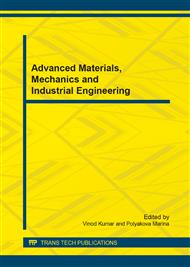[1]
Adam C. Esser, MD, James G. Koshy, Ph. D, Henry W. Randle, MD, Ph.D. Ergonomics in Office-Based Surgery: A Survey-Guided Observational Study,. American Society for Dermatologic Surgery, Inc. November (2007).
DOI: 10.1097/00042728-200711000-00002
Google Scholar
[2]
Franco G and Fusetti L. Bernardino Ramazzini's early observations of the link between musculoskeletal disorders and ergonomic factors, Applied Ergonomics, vol. 35, no. 1, pages 67-70, January (2004).
DOI: 10.1016/j.apergo.2003.08.001
Google Scholar
[3]
Grace P. Y. Szeto, Pei Ho, Albert C. W. Ting, Jensen T. C. Poon, Stephen W. K. Cheng, Raymond C. C. Tsang. Work-related Musculoskeletal Symptoms in Surgeons,. Journal of Occupational Rehabilitation (2009).
DOI: 10.1007/s10926-009-9176-1
Google Scholar
[4]
C. J. Walsh, A quasi-passive leg exoskeleton for load-carrying augmentation, Int. J. Hum. Robot vol. 4, no. 3, p.487–506, (2007).
DOI: 10.1142/s0219843607001126
Google Scholar
[5]
J. E. Pratt, B. T. Krupp, C. J. Morse, and S. H. Collins, The RoboKnee: An exoskeleton for enhancing strength and endurance during walking, in Proc. IEEE Int. Conf. Robot. Autom., New Orleans, p.2430–2435, (2004).
DOI: 10.1109/robot.2004.1307425
Google Scholar
[6]
Jennifer A. Sivak-Callcott, M. D, Sebastian R. Diaz, Ph. D, Alan M. Ducatman, M.D., Charles L. Rosen, M.D., Ph., Ashish D. Nimbarte, Ph.D., and Judith A. Sedgeman, Ed.D. A Survey Study of Occupational Pain and Injury in Ophthalmic Plastic Surgeons,. Ophthalmological Plastic Reconstruction Surgery, Vol. 27, No. 1, 201.
DOI: 10.1097/iop.0b013e3181e99cc8
Google Scholar
[7]
Krause N and others. Standing at work and progression of carotid atherosclerosis, Scandinavian Journal of Work, Environment and Health, vol. 26, no. 3, pages 227-36, (2000).
Google Scholar
[8]
Linder M and Salzman CL. A history of medical scientists and high heels, International Journal of Health Services, vol. 28, no. 2, pages 201-225, (1998).
Google Scholar
[9]
McCulloch J. Health risks associated with prolonged standing. Work, vol. 19, no. 2, pages 201-5, (2002).
Google Scholar
[10]
M. Frey, G. Colombo, M. Vaglio, R. Bucher,M. Jorg, R. Riener, A novel mechatronic body weight support system, IEEE Trans. Neural Syst. Rehabil. Eng., vol. 14, no. 3, pp.311-321, (2006).
DOI: 10.1109/tnsre.2006.881556
Google Scholar
[11]
P. Métrailler, R. Brodard, Y. Stauffer, R. Frischknecht, R. Clavel, Cyberthosis: Rehabilitation Robotics with Controlled Electrical Muscle Stimulation, Book: Rehabilitation Robotics, Ch. 17, I-Tech Education and Publishing, (2007).
DOI: 10.5772/5167
Google Scholar
[12]
Prolonged standing: Taking the load off. Workers' Health and Safety Centre, Canada, (2002).
Google Scholar
[13]
Tüchsen F, Krause N and others. Standing at work and varicose veins, Scandinavian Journal of Work, Environment and Health, vol. 2 no. 5, pages 414-20, (2000).
DOI: 10.5271/sjweh.562
Google Scholar
[14]
Weinberg B., Nikitczuk J. , Patel S., Patritti B. , Mavroidis C. , Bonato P. , Canavan P. Design, control and human testing of an active knee rehabilitation orthotic device. IEEE International Conference on Robotics and Automation, Roma, , April 10-14 (2007).
DOI: 10.1109/robot.2007.364113
Google Scholar
[15]
A. M. Dollar, H. Herr, Lower Extremity Exoskeletons and Active Orthoses: Challenges and State-of-the-Art, IEEE Trans. Rob., vol. 24, no. 1, (2008).
DOI: 10.1109/tro.2008.915453
Google Scholar


